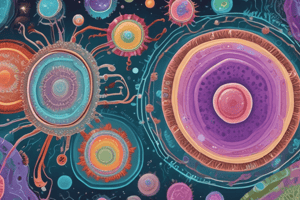Podcast
Questions and Answers
What is the purpose of calcium dipicolinate in the formation of endospores?
What is the purpose of calcium dipicolinate in the formation of endospores?
- To pinch off the plasma membrane
- To break down the peptidoglycan cortex
- To form the spore coat
- To stabilize the proteins and DNA in the endospore (correct)
What is the final stage of endospore formation?
What is the final stage of endospore formation?
- Formation of the spore coat
- Pinching off of the plasma membrane
- Replication of DNA
- Dehydration and maturation of the endospore (correct)
What is the primary function of ribosomes in all organisms?
What is the primary function of ribosomes in all organisms?
- To store nutrients
- To store genetic information
- To synthesize proteins (correct)
- To regulate metabolism
What is the function of the cortex in the endospore?
What is the function of the cortex in the endospore?
What is the process by which a single endospore forms within some bacteria?
What is the process by which a single endospore forms within some bacteria?
What is the composition of the 50S subunit of a 70S ribosome?
What is the composition of the 50S subunit of a 70S ribosome?
What is the purpose of plasmids in genetic engineering?
What is the purpose of plasmids in genetic engineering?
What is the structure that forms between the DNA and the rest of the cell during endosporulation?
What is the structure that forms between the DNA and the rest of the cell during endosporulation?
What is the characteristic of endospores that makes them resistant to adverse conditions?
What is the characteristic of endospores that makes them resistant to adverse conditions?
What is the characteristic of the endospore that allows it to resist UV light and harsh chemicals?
What is the characteristic of the endospore that allows it to resist UV light and harsh chemicals?
What is the function of gas vacuoles in some aquatic bacterial inclusions?
What is the function of gas vacuoles in some aquatic bacterial inclusions?
What is the composition of ribosomes in eukaryotes?
What is the composition of ribosomes in eukaryotes?
What is the purpose of inclusion granules in bacteria?
What is the purpose of inclusion granules in bacteria?
What is the purpose of Bacillus stearothermophilus spores?
What is the purpose of Bacillus stearothermophilus spores?
What is the approximate water composition of the cytoplasm in a prokaryotic cell?
What is the approximate water composition of the cytoplasm in a prokaryotic cell?
What is the primary function of the cytoplasm in a prokaryotic cell?
What is the primary function of the cytoplasm in a prokaryotic cell?
What is the function of mesosomes in prokaryotic cells?
What is the function of mesosomes in prokaryotic cells?
What is the characteristic of the nucleoid in prokaryotic cells?
What is the characteristic of the nucleoid in prokaryotic cells?
What is the primary function of plasmids in prokaryotic cells?
What is the primary function of plasmids in prokaryotic cells?
What is the characteristic of conjugative plasmids?
What is the characteristic of conjugative plasmids?
What is an example of a virulence factor conferred by a plasmid?
What is an example of a virulence factor conferred by a plasmid?
What is the range of base pairs in prokaryotic chromosomes?
What is the range of base pairs in prokaryotic chromosomes?
Flashcards are hidden until you start studying
Study Notes
Bacterial Internal Structures
- Cytoplasm: a gel-like matrix composed of 80% water, containing nucleic acids (DNA and RNA), enzymes, amino acids, carbohydrates, lipids, inorganic ions, and many low molecular weight compounds.
- Functions of cytoplasm: site of most bacterial metabolism, leading to growth and replication.
Mesosomes
- Mesosomes: plasma membrane infoldings.
- Functions of mesosomes:
- Role in the formation of cell walls.
- Replication of DNA in prokaryotes.
- Increase plasma membrane surface area and enzymatic content.
- Aid in the transfer of chromosomes to daughter cells.
- Analogous to cristae in the mitochondria of eukaryotic cells.
Nucleoid
- Nucleoid: also known as chromatin body, no nuclear membrane or nucleoli.
- Characteristics of nucleoid:
- Single circular chromosome of double-stranded, supercoiled DNA.
- No nuclear membrane.
- No nucleolus.
- No mitotic spindle.
- No histones.
- Size: 580,000 base pairs in Mycoplasma gallinarum to 9,140,000 bp in Myxococcus xanthus.
Plasmids
- Plasmids: small, nonessential, extra-chromosomal DNA, circular (linear in a few species).
- Characteristics of plasmids:
- Present in cytoplasm, but may become incorporated into chromosomal DNA.
- Often confer protective traits such as drug resistance or the production of toxins and enzymes.
- Passed on in conjugation.
- Replicate independently.
- Examples: antibiotic resistance, virulence factors, and conjugative plasmids.
Ribosomes
- Ribosomes: the most abundant in the cytoplasm, up to 15,000 ribosomes.
- Characteristics of ribosomes:
- 70S ribosomes in prokaryotes, composed of 50S and 30S subunits.
- 50S subunit contains 23S and 5S rRNA, and 30S subunit contains 16S rRNA.
- Chemically composed of ribosomal RNA (rRNA) and protein.
- Function as a workbench for protein synthesis – translation of mRNA into proteins.
Inclusion Granules
- Inclusion granules: nonliving components, not bounded by membranes, several kinds of reserve deposits.
- Examples: volutin granules, polysaccharide granules, lipid inclusions, sulfur and nitrogen granules, and gas vacuoles.
Endospores
- Endospores: dormant, resistant structures, produced intracellularly upon starvation.
- Characteristics of endospores:
- Resistant to adverse conditions: high temperatures, irradiation, cold, and organic solvents.
- Contain calcium dipicolinate.
- Not a mechanism of reproduction.
- Examples: Bacillus and Clostridium species.
- Formation: through endosporulation, involving DNA replication, spore septum formation, peptidoglycan cortex, and spore coat formation.
- Structure: cortex, core, and inner membrane, leading to resistance against UV light and harsh chemicals.
Studying That Suits You
Use AI to generate personalized quizzes and flashcards to suit your learning preferences.




